Understanding Participatory Hashtag Practices on Instagram: A Case Study of Weekend Hashtag Project
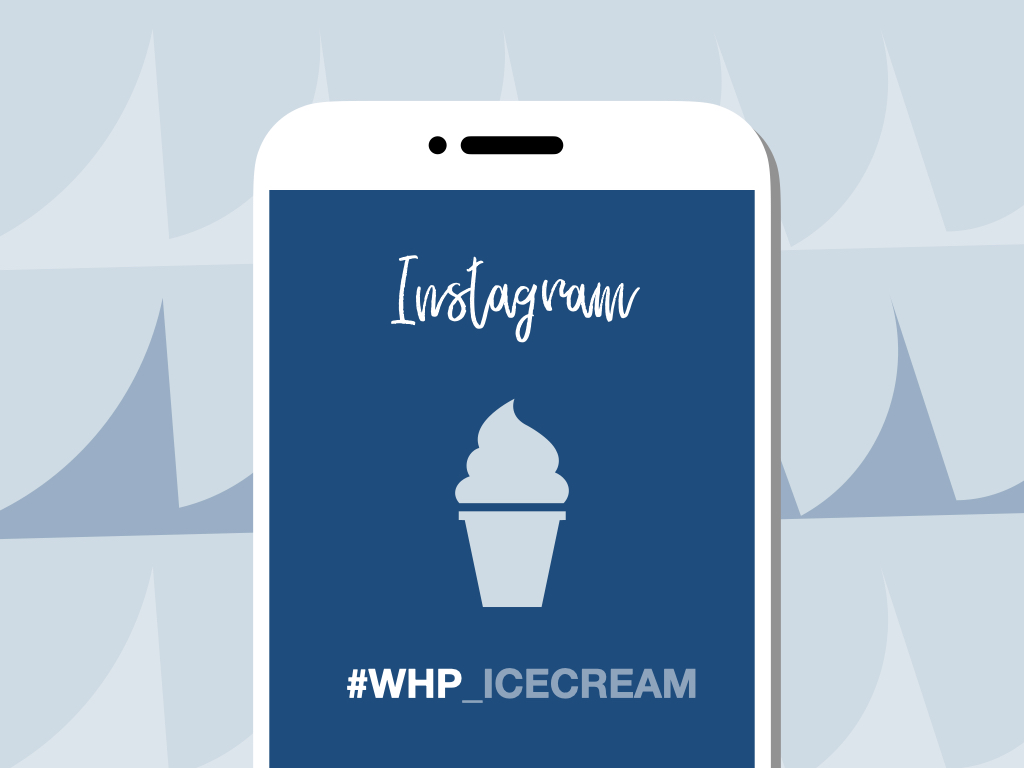
People tag their images with various motivations while using social media. It not only allows them to organize images but also makes it possible for other users to locate images by communicating contextual information. Instagram, a worldwide popular photo- sharing platform, also involves key user interactions centered on posting images accompanied with hashtags and the increase in Instagram’s popularity has given rise to its unique and various hashtagging practices. Instagram users engage diverse tagging practices, and form and develop networks based on these tags.
Among these diverse tagging practices, we focus on a unique collaborative hashtagging phenomenon, where a certain user account suggests a hashtag to its followers and promotes them to upload photos suitable to the hashtag. In this paper, we name this interesting phenomenon with the term “participatory hashtag practice,” to explain its unique characteristics. As there is a growing interest in using social media as a marketing platform, understanding users’ participatory hashtagging behaviors could provide businesses with insights and strategies for interacting with potential consumers. Instagram, which is centered on visual communication with numerous users, could be an especially effective platform which companies and organizations could use to promote their brand images. Although many studies have been carried out on social media platforms to investigate the characteristics of these participatory tagging behaviors, this has not been addressed sufficiently on Instagram. To that end, it would be worthwhile to characterize user behaviors in participatory hashtagging on Instagram and explore strategies for improving user engagement.
In this respect, we have tried to understand Instagram users’ participatory hashtagging practices by conducting a case study of the Weekend Hashtag Project (#WHP), the most influential participatory hashtag project on Instagram. The #WHP series features designated themes and hashtags chosen by Instagram’s community team. Followers of Instagram’s official account receive a new project every Friday, which encourages participants to post creative photographs matching the chosen theme (Figure 1). To obtain insights into participatory hashtagging practices, we asked the following questions: (1) How do Instagram users respond to the Weekend Hashtag Project? (2) What motivates Instagram users to take part in the Weekend Hashtag Project?
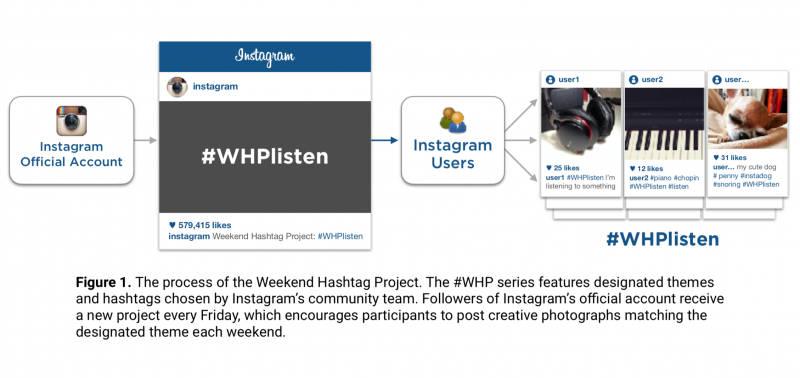
To answer each question, we designed our study using both quantitative and qualitative methods. Through the quantitative study, we found that #WHP post distribution shows two main trends: tag explosion and retagging. In addition, by conducting a qualitative study, we identified factors motivating users to take part in this participatory hashtag project: retrospective viewpoints, diverse representation, and a sense of belonging. Based on these findings, we offer design strategies for any interested parties that endeavor to interact effectively with their followers.
User Study 1: Tag Distribution Analysis
Through quantitative research, we analyzed how Instagram users respond to #WHP, and found major trends in the hashtag post distributions.
Methodology
Using the Instagram API, we crawled all #WHP posts from July 21, 2012 (#WHPjumpstagram), to April 25, 2015 (#WHPdoubletake), and collected 136 #WHP hashtags. The total number of posts collected was approximately 1.7 million, and the average number of posts per project was approximately 12,400. We produced distribution plots for each of the #WHP hashtags, and conducted a time series analysis.
Result
Our analysis of #WHP hashtag post distribution reveals two main trends: tag explosion and retagging (Figure 2). Although the moments of explosive tagging differ slightly because the starting date of each #WHP varies, all the graphs show a similar pattern. The average Pearson similarity coefficient of all the pairs from 136 hashtag post distribution plots is 0.85 (SD=0.14) and more than 90% of the coefficient values are higher than 0.7.
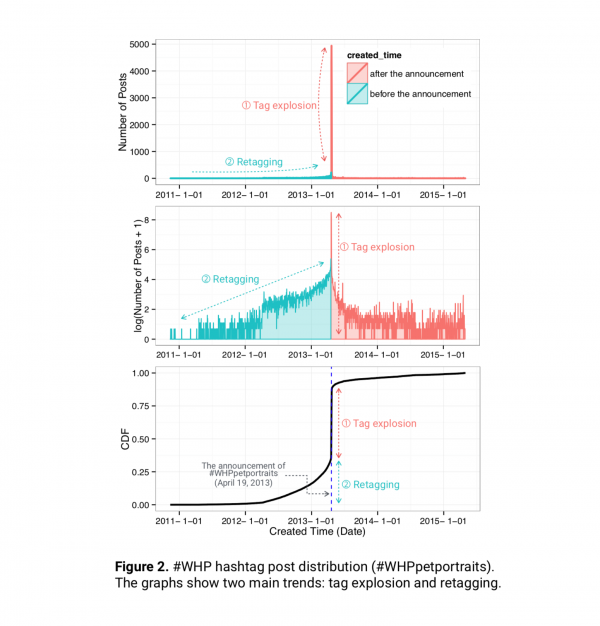
Tag Explosion
As shown in Figure 2, tag explosion refers to a sudden burst in the number of newly created posts containing the #WHP hashtag immediately after the announcement of the #WHP. From the data set, 47.64% of total posts were observed during the first three days and 50.67% during the first five days. The number of posts then sharply declined and lagged, with a small number of posts occurring. This explosive increase in the number of posts is similar to the results of previous studies on information diffusion in social media networks. The cascades of information often create sudden bursts on social media platforms such as Twitter, expanding the spread of information in an instant. Likewise, in #WHP, a number of users participated in the project by uploading posts containing the #WHP tags in a short period, but this level of activity was not sustained.
Retagging
Furthermore, we identified retagging from the distribution. This phenomenon refers to tagging behavior where users add #WHP to old posts uploaded previously. As shown in Figure 2, the number of old posts containing the #WHP hashtag steadily increases before the announcement of each project. We observed this retagging every week, and 34.42% of total posts accounted for this. In addition, more than half of these tags (55%) are observed in comments, which means the participants wrote comments containing #WHP on their old posts.
This retagging phenomenon is notable, as it represents the unique and intrinsic characteristics of the Instagram platform. By retagging, users just add certain hashtags to their old posts to create new meanings and interpretations of their photo collections. While using social media, it is uncommon for users to update old posts; if they do, they typically edit posts containing information regarding something they regret, and people tend to upload new posts to update their status. Moreover, retagging differs from retweeting in Twitter or reposting in Facebook, where spreading the original post (tweet) or exposing the old post to the newsfeed requires retweeting or reposting the original content. In contrast, retagging does not have such functions; users retag old posts to add new meaning and a new interpretation while participating in the project. We attempted to identify the user experience behind this phenomenon in the interviews.
User Study 2: Interviews
We interviewed Instagram users who participate in #WHP to understand what encourages them to do so.
Methodology
We planned a semi-structured interview and a survey with open-ended questions, and targeted Instagram users who had participated in the #WHP previously. We posted a recruitment advertisement in an online university student community. In addition, we randomly selected 1,500 usernames from our sample data set and sent these users a direct message asking them to participate in the study. We finally recruited 19 participants: 5 participants took part in the semi- structured interviews, and 14 participants completed the online survey. The participants were asked about their general use of Instagram as well as more detailed questions about their experience of participating in the #WHP. We transcribed all the interviews and cross- analyzed them with survey responses. Three researchers took ideation sessions, which consists of the stages of coding, note taking, and integrating, and categorized main issues from the results.
Result
Retrospective Viewpoints
Usually, the participants attempted to take a picture of the object the WHP hashtag suggested. However, in many cases, participants looked through their photo albums and searched for the most relevant photos for the hashtag. Some participants recalled the most appropriate photo in their photo albums the instant they saw the project tag. They simply uploaded these pictures, adding the #WHP tag (Figure 3).
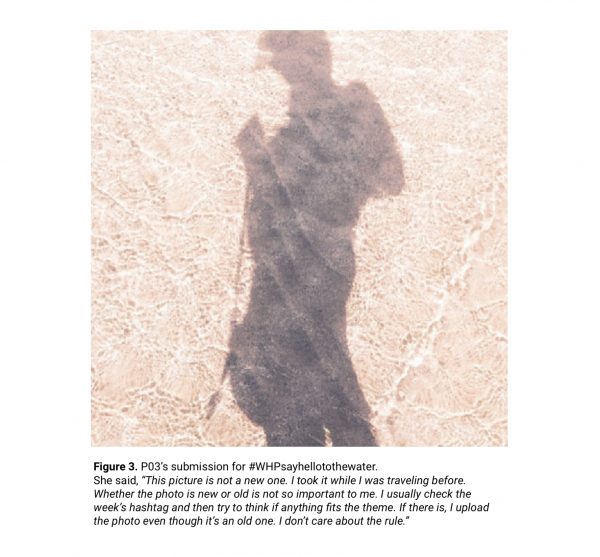
As we found through retagging in the previous stage, several participants tagged #WHP to old posts they had uploaded before. P02 explained, “I’ve [retagged] it because I recalled a good picture in my feed that perfectly fits the hashtag project,” while P04 admitted, “Yeah, I did it, because they perfectly matched the week’s theme.” The participants did not hesitate to submit old posts if the photos perfectly corresponded to the project tag. P05, although he had never tried the retagging practice, expressed his willingness to add a tag to his old post: “That’s a good idea. I usually upload my best photos on Instagram. All the photos on my feed are the best ones. So, if I find the tag that fits one of my posts, of course I will tag it because it would be a chance to show one of my best photos.”
Providing users with the opportunity to recall old memories or look back on content could be a good way to enhance user engagement with the platform. According to the study on #ThrowbackThursday (#TBT), another representative participatory hashtag practice on Instagram, users can feel nostalgia while participating in the project. This retrospective experience can provide individuals with a sense of continuity, helping them make better sense of their lives. While taking part in the hashtag project, users ascribe new meanings to old experiences and share them with others, enhancing the sense of engagement in the project.
Possibility of Diverse Representation
We identified that many users (such as P02, P03, P04, and P17) enjoyed devising their own strategies while taking part in the project. When given the #WHP hashtag, they contemplated and reinterpreted its meaning, reflecting their own contexts. For example, P17, while participating in the tag #WHPartifacts, interpreted the meaning of the word “artifact” and added his thoughts to his photo, thereby differentiating his post. He also received more likes than ever before, which gave him personal satisfaction (Figure 4).
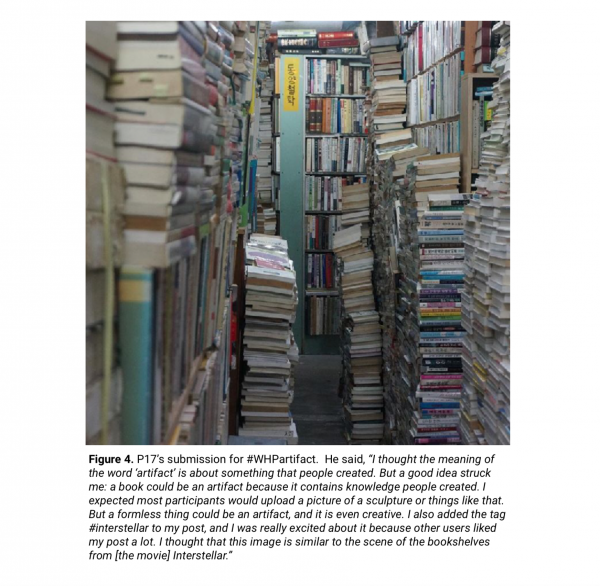
Simultaneously, participants experienced pleasure as an audience while browsing #WHP posts other users had uploaded. Looking through diverse photos with the same hashtag, they enjoyed other users’ originality.
Moreover, some participants stated that #WHP photos seem far more creative than other pictures, with higher quality. P19 noted, “These [pictures] are so pretty. Of course, other images are also pretty. But WHP pictures are better.” P03 remarked, “I can feel the culture code from the posts. People take photos from all around the world on their own terms.”
This diverse visual representation arises in part from the way posts are uploaded in the Weekend Hashtag Project. P12 said, “It was fascinating to me how people interpret the same tag in different ways. We saw the same keyword, but everybody uploaded different pictures. Isn’t it interesting?” Similarly, P04 mentioned this, describing his general uploading routine: He usually takes a picture or selects one from his photo album, then edits the photo. As the final step, he adds appropriate hashtags to describe the image. In contrast, while participating in the #WHP, he faces the reverse situation: the tag is fixed beforehand, and he has to describe the tag with an appropriate photo. That is, the process of #WHP tagging could be a visual representation of a verbal expression. Images become more sophisticated and structured through tags, and tags, in turn, facilitate the creation of various photos, increasing social creativity. This process could enhance users’ engagement and facilitate their participation in the Instagram project as well.
Sense of Belonging in the #WHP Community
Some of the participants indicated that the Weekend Hashtag Project is like a game wherein users can complete quests to earn rewards and beat competitors. P12 explained, “I often think the tags are too difficult. It is not easy to find the object. But it’s not that tough, because according to the mission, I can decide whether I will participate in the project or not. It’s like a quest. It’s not that burdensome.” He described the project as a quest containing various levels of difficulty. In addition, P14 mentioned, “It’s like a competition to be chosen on the Instagram feed, and who doesn’t like drawing attention?” Participating in the project, he saw it as a contest wherein numerous participants compete for the Instagram community’s attention.
As Instagram shares its favorite submissions and congratulates users by tagging their usernames on the post, users have the opportunity to promote their accounts to the public and gain many followers. Through this process, users have a chance to interact with various members of the Instagram community. P16 reported, “I have tagged them, because not only do I want to enter them into the competition, but it also allows photographers with similar tastes and interests to look at my pictures and perhaps like them or follow my account. I can like their photos or follow their accounts if I like them.” The participation in the #WHP could be a chance to meet photographers who have the same tastes. In addition, feedback from other users, such as likes and comments, also enhance participants’ user experiences. P17 said, “I got so many likes. This is my personal record. I didn’t expect that I could earn many likes. This feels awesome! I’ll do this again next time. Any hashtags will be okay.” As appropriate feedback could affect user behavior in an online community, attention from other Instagram users seems to have encouraged users’ consistent participation in the project.
Discussion and Conclusion
In this study, we endeavored to characterize participatory hashtag practices on Instagram by conducting a case study of Instagram’s Weekend Hashtag Project. We identified common patterns of posting consisting of two parts: tag explosion and retagging. Especially retagging is specific to Instagram, as it allows users to reinterpret their photos and add new meanings to the hashtag. In addition, we discovered three main motivations of user engagement in the project: retrospective viewpoints, diverse representation, and a sense of belonging to the community. Based on these findings, we offer the following design strategies for interested parties to communicate and interact with users on Instagram:
- Encourage users to actively utilize their previous experience
- Provide users with room for diverse interpretation and representation in their own way
- Offer users appropriate feedback that can make them feel involved in the user community
Our contributions to the HCI field include that this study pioneered understanding of a user’s tagging behavior on Instagram, focusing on a specific practice that has not yet been studied. We hope that our approach inspires future research on the participatory culture in social media. Moreover, by investigating participatory hashtag practices among Instagram users, we provide insights and design strategies for interacting with users on social media.
In the future work, we plan to extend this research in an attempt to generalize the issues of participatory hashtag practices in social media. We will conduct comparison studies with other hashtag projects and other social media platforms.
- Instagram Blog. 2015. Retrieved August 15, 2015 from http://blog.instagram.com
- Morgan Ames and Mor Naaman. 2007. Why we tag: motivations for annotation in mobile and online media. In Proceedings of the SIGCHI Conference on Human Factors in Computing Systems (CHI ’07). ACM, New York, NY, USA, 971-980. http://dx.doi.org/10.1145/1240624.1240772
- Justin Cheng, Cristian Danescu-Niculescu-Mizil, and Jure Leskovec. 2014. How community feedback shapes user behavior. In Proceedings of the 8th International AAAI Conference on Weblogs and Social Media (ICWSM ’14).
- Wing-Yee Cheung, Tim Wildschut, Constantine Sedikides, Erica G. Hepper, Jamie Arndt, and Ad J. J. M. Vingerhoets. 2013. Back to the Future Nostalgia Increases Optimism. Personality and Social Psychology Bulletin 39, 11: 1484-149.
- Emilio Ferrara, Roberto Interdonato, and Andrea Tagarelli. 2014. Online popularity and topical interests through the lens of Instagram. In Proceedings of the 25th ACM conference on Hypertext and social media (HT ’14). ACM, New York, NY, USA, 24-34. http://dx.doi.org/10.1145/2631775.2631808
- Kyungsik Han, Jin Yea Jang, and Dongwon Lee. 2015. Exploring Tag-based Like Networks. In Proceedings of the 33rd Annual ACM Conference Extended Abstracts on Human Factors in Computing Systems (CHI EA ’15). ACM, New York, NY, USA, 1941-1946. http://dx.doi.org/10.1145/2702613.2732908
- Jeff Huang, Katherine M. Thornton, and Efthimis N. Efthimiadis. 2010. Conversational tagging in twitter. In Proceedings of the 21st ACM conference on Hypertext and hypermedia (HT ’10). ACM, New York, NY, USA, 173-178. DOI=http://dx.doi.org/10.1145/1810617.1810647
- Bernard J. Jansen, Mimi Zhang, Kate Sobel, and Abdur Chowdury. 2009. Twitter power: Tweets as electronic word of mouth. Journal of the American society for information science and technology 60, 11: 2169-2188.
- Andreas M. Kaplan, Michael Haenlein . 2010. Users of the world, unite! The challenges and opportunities of Social Media. Business horizons 53, 1:59-68.
- Colleen Leahey. 2015. Throwback Thursday: The psychology behind its success. Retrieved September 26, 2015 from http://fortune.com/2014/05/01/throwback- thursday-the-psychology-behind-its-success/
- T.C. Melewar, Kara Bassett, and Cláudia Simões. 2006. The role of communication and visual identity in modern organisations. Corporate Communications: An International Journal 11, 2: 138 – 147.
- Seth A. Myers and Jure Leskovec. 2014. The bursty dynamics of the Twitter information network. In Proceedings of the 23rd international conference on World wide web (WWW ’14). ACM, New York, NY, USA, 913-924. http://dx.doi.org/10.1145/2566486.2568043
- Oded Nov and Chen Ye. 2010. Why do people tag?: motivations for photo tagging. Commun. ACM 53, 7 (July 2010), 128-131. http://dx.doi.org/10.1145/1785414.1785450
- Bernard H. Russell and Gery W. Ryan. 2009. Analyzing qualitative data: Systematic approaches. SAGE publications.
- Markus Strohmaier, Christian Körner, and Roman Kern. Why do Users Tag? Detecting Users’ Motivation for Tagging in Social Tagging Systems. 2010. In Proceedings of the 4th International AAAI Conference on Weblogs and Social Media (ICWSM ’10).
- Yang Wang, Gregory Norcie, Saranga Komanduri, Alessandro Acquisti, Pedro Giovanni Leon, and Lorrie Faith Cranor. 2011. “I regretted the minute I pressed share”: a qualitative study of regrets on Facebook. In Proceedings of the Seventh Symposium on Usable Privacy and Security (SOUPS ’11). ACM, New York, NY, USA, , Article 10 , 16 pages. http://dx.doi.org/10.1145/2078827.2078841
- Lei Yang, Tao Sun, Ming Zhang, and Qiaozhu Mei. 2012. We know what @you #tag: does the dual role affect hashtag adoption?. In Proceedings of the 21st international conference on World Wide Web (WWW ’12). ACM, New York, NY, USA, 261-270. DOI=http://dx.doi.org/10.1145/2187836.2187872



